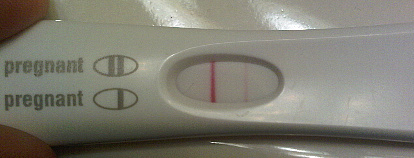After 4 years, 1 month and 17 days of trying, I'm thrilled to announce that I'm expecting our third child in March. We are, of course, planning a midwife-assisted homebirth.

So, why did I wait so long to share the news?
Well, at first I didn't know I was pregnant. I'd had pneumonia the entire month of June, preceded by the flu, so the last thing I was expecting after all this time was a positive pregnancy test. I also have extremely irregular cycles, ranging from 25-62 days, so I literally can never count on when I'm officially "late" from month to month. And after many, many negative tests in the past, I avoid testing all all cost unless I truly think that I could indeed be pregnant.
I also wanted to be cautiously optimistic until I was certain that things were developing normally. I didn't want to share the news, only to have to un-share at a later date. We've always been late sharers - not until about 12-14 weeks with both of our other children.
This is also why we also didn't tell our children until about 8 weeks, when my morning sickness became too severe to write off as the flu.
For those who are interested, here's a short recap of the past 4 months:
Wake Up
~ An Hour Later ~
Vomit
~ An Hour Later ~
Vomit
~ An Hour Later ~
Vomit
~ An Hour Later ~
Vomit
...you get the picture.
The first 3 months were a nonstop blur of vomiting, broken capillaries in my face and constant nausea when I wasn't vomiting. It made me very thankful that my other children are older so that it didn't scare them and I was still able to care for them. My husband was the greatest help, taking over meals, handling most of the housework, etc so that I could take care of myself.
I've rarely been sick in all the years we've been married, so this was quite a new experience for us. I couldn't have gotten through it so smoothly without him.
Despite this rough start, I'm still thrilled to be expecting and it has been worth every moment with my head in a bucket to date. It just gets better from here on out and I'm continually excited for each new development that transpires.
Things that Are Different from My Previous Pregnancies
I thought it might be useful to compare and contrast my previous pregnancies, so here's a run-down of the most significant differences to date.
- Severe Morning Sickness
- I was not sick a day with my first and only had mild morning sickness with my second. This time around, I wasn't able to keep much of anything down for the first 12 weeks and even passed out on occasion (not a great experience). It started to ease off after about 13 weeks and now it's down to daily nausea, but no vomiting. I still have to be careful about what I eat, drink and smell, but it's completely manageable at this point.
- Fainting
- I never came close to passing out before, and was utterly shocked to wake up on the floor when it happened.
- Braxton-Hicks
- While I typically start to experience Braxton-Hicks around 16 weeks, this time they were noticeable starting at 14 weeks.
- Fetal Movement
- With my first, I felt fetal movement around 14 weeks and by 17 weeks, my husband could watch her moving inside my abdomen. With my second, I had an anterior placenta, so although I felt fetal movement around the same time, they didn't increase in strength until about 17 weeks, and weren't visible until around 18 weeks.
This time, I first felt fetal movement around 13.5 weeks, but at this time it's still mainly little pokes and prods. I did start feeling more whole-body type movements just yesterday. This makes me suspect another anterior placenta.
Progress Toward Homebirth
The first challenge we faced was finding a midwife. We live in an extremely rural area where there are few options for OBs, let alone midwives. Due to my history of extremely rapid labors, distance was also a factor in selecting a midwife who actually has a chance of reaching us in time.
The first midwife I contacted was unable to accept due to a scheduled vacation right when I was due, with clients both before and after. I know how difficult it can be to get away and completely understand that you can't be everything to everyone all the time; sometimes, you have to say no.
Thus, I was down to a single option - if she couldn't take me, then I would have to search for an underground CPM (my state has a very hostile climate toward homebirth, with or without a CNM in attendance) within range who could attend me.
Luckily, she was willing to accept me. My next appointment is this evening, which I'm eagerly anticipating. At my last appointment, she had two clients who she thought might both have their babies that night, so I'm anxious to see what transpired.
I intend to make regular updates on our progress and preparation toward our homebirth, which will be filmed and shared on GivingBirthNaturally.com, so check back often for updates.
I'm not really showing much yet, but I'll post a picture of my belly-to-date soon.

